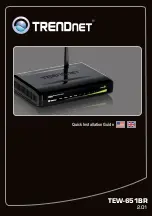
Manage the MTU Size
The maximum transmission unit (MTU) is the largest data packet a network device transmits.
MTU Concepts
When one network device communicates across the Internet with another, the data packets travel through
many devices along the way. If a device in the data path uses a lower maximum transmission unit (MTU)
setting than the other devices, the data packets must be split or “fragmented” to accommodate the device
with the smallest MTU.
The best MTU setting for NETGEAR equipment is often the default value. In some situations, changing the
value fixes one problem but causes another.
Leave the MTU unchanged unless one of these situations occurs:
•
You experience problems connecting to your ISP or other Internet service, and the technical support of
either the ISP or NETGEAR recommends changing the MTU setting. These web-based applications
might require an MTU change:
-
A secure website that does not open or displays only part of a web page
-
Yahoo email
•
You use VPN and experience severe performance problems.
•
You used a program to optimize MTU for performance reasons and now you are experiencing connectivity
or performance problems.
If you suspect an MTU problem, a common solution is to change the MTU to 1400. If you are willing to
experiment, you can gradually reduce the MTU from the maximum value of 1500 until the problem goes
away. The following table describes common MTU sizes and applications.
Table 2. Common MTU sizes
Application
MTU
The largest Ethernet packet size. This setting is typical for connections
that do not use PPPoE or VPN and is the default value for NETGEAR
routers, adapters, and switches.
1500
Used in PPPoE environments.
1492
Maximum size to use for pinging. (Larger packets are fragmented.)
1472
Used in some DHCP environments.
1468
Specify Your Internet Settings
36
AC1750 Smart WiFi Router Model R6350
















































